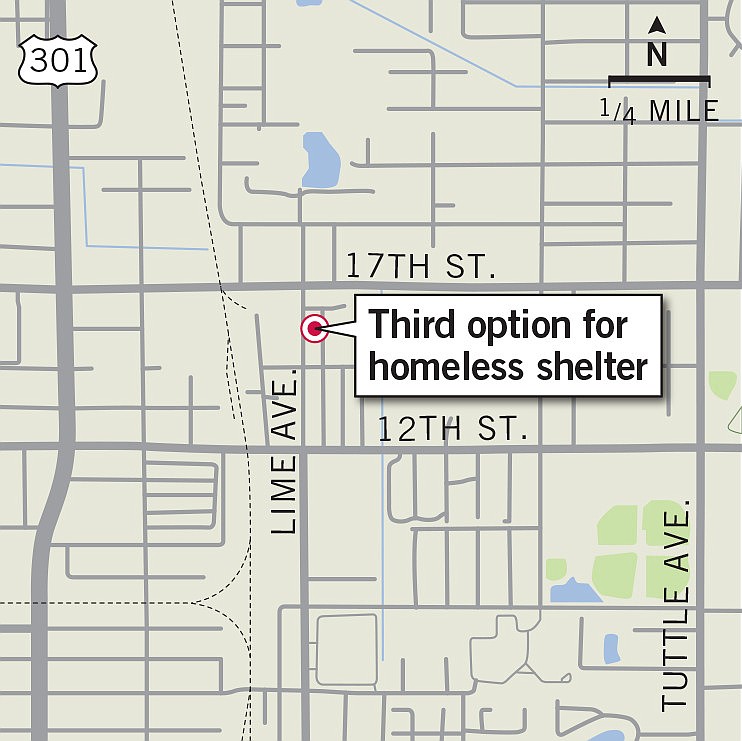- April 25, 2024
-
-
Loading

Loading

City and county commissioners failed to reach an agreement Tuesday on where to build a downtown Sarasota homeless shelter, casting doubt on whether the project will be built in the near future — if at all.
The two commissions did, however, compromise on adding the property at 1502 and 1562 N. Lime Ave. as a third option to the sites at 1330 N. Osprey Ave. and 1800 East Ave., which city staff are currently evaluating.
Tuesday’s joint city-county commission was the latest round in an ongoing bout between the two boards over where to build a “come as you are” shelter. Homelessness expert Dr. Robert Marbut, whom the city and county commissioned last year to study homelessness in the area, recommended the shelter in his report.
Marbut said a downtown shelter is needed to pull individuals off the streets and into programs that teach job skills and provide treatment for mental illnesses and substance abuse.
County commissioners support Marbut’s recommendations and are pushing to move the project forward. City Commissioners Susan Chapman and Willie Shaw, as well as many downtown business owners and residents, oppose the project. They claim it will increase violent crime and diminish property values in nearby areas. Chapman also said the two original sites were not properly vetted and are problematic for a variety of reasons, including their impact on the city’s utilities infrastructure and other homeland security concerns.
Some commissioners praised Tuesday’s compromise as a positive step, while others were less optimistic, claiming they had only prolonged the selection process by adding a third site to the list of locations to be vetted.
City commissioners voted 4-1 to approve the Lime Avenue property as a third site option for the shelter. City Commissioner Susan Chapman was the one dissent.
The 34,000-square-foot building on the site meets the requirements Marbut outlined for the facility, which include its proximity to other downtown social services. At an estimated price of $750,000, it is, however, more expensive than the other two options, according to Sarasota County Director of Homeless Services Wayne Applebee.
Yet it was worries about the threat of violent crime downtown and diminished property values that dominated the public testimony period Tuesday.
Chapman questioned Marbut and Applebee about those concerns.
Marbut said his research did not support the correlation between homeless shelters and an increase in violent crime. Marbut pointed to Pinellas County, which saw a 91% reduction in street homelessness following the opening of the Pinellas Safe Harbor homeless shelter there in 2011, as proof of the facility’s value.
Marbut also challenged the scientific value of data Chapman used to argue homeless shelters reduce nearby property values. He explained the nationwide drop in the housing market since 2008 made it difficult to attribute a dip in property values to any one variable.
“The devaluation of property values is more affected by the housing market crash,” Marbut said.
Chapman also asked Applebee whether his evaluation of the two original sites included reviewing impacts on the city’s electric grid, sewer system, water supply, as well as potential homeland security concerns.
Applebee said those issues were included in the city’s environmental assessments of the sites.
Marbut also contested the claim that the shelter would draw more homeless to the area.
“People are already coming here because of the weather; weather is your No. 1 draw,” Marbut said. “Homeless will always come to South Florida.”
Chapman also used Tuesday’s forum to push back against claims that she was intentionally trying to subvert the selection process and prevent the shelter from being built.
“It has been said that I am trying to sabotage the process,” Chapman said to Applebee, while questioning him about his work with city staff in choosing a site. “Have you sensed any lack of cooperation from city staff in preceding with this endeavor?”
County Commissioner Christine Robinson told Applebee not to answer the question. County Administrator Tom Harmer ultimately responded: “I don't know that I can specifically answer that question.”
Several county commissioners, however, were less reticent to critique the city’s selection and environmental review processes.
“From reading the different emails, there is a perception in mind that the administration at the city is putting up roadblocks at times with respect to the Osprey Avenue site,” County Commissioner Carolyn Mason said, referring to the city’s claim that the North Osprey site was unavailable until 2015 due to its use as a staging area for a nearby deep-injection well project.
City commissioners painted Tuesday’s compromise on selecting a third site as an indication of increased cooperation between the city and county moving forward.
“The city is simply doing due diligence on these sites,” City Commissioner Suzanne Atwell said. “I believe the County Commission and staff are full partners … we need to stop pitting those who want the same outcome against each other.”
Some county commissioners, however, expressed concern that the new site would simply invite the same criticisms as the original two sites, further delaying the selection process in the end.
“There is no site that we can pick that will not impact residential areas,” Mason said.
The city and county commissions will reconvene April 22 for another joint meeting to review preliminary assessments of the Lime Avenue location.
Contact Nolan Peterson at [email protected]